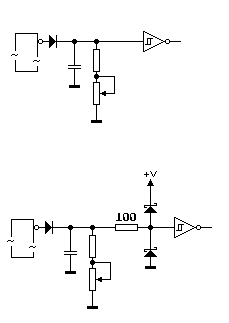| Author |
Message |
bingmachine
Joined: Jan 23, 2009
Posts: 19
Location: Sweden
|
 Posted: Sat Jan 24, 2009 6:22 am Post subject: Posted: Sat Jan 24, 2009 6:22 am Post subject:
 TR-505 individual outs, strange behaviour from a schmitt-tr TR-505 individual outs, strange behaviour from a schmitt-tr |
  |
|
Hi,
I'm new to this forum, and to electro-music in all. Seems like a really nice place.
Now, I'm doing some circuit-bending on a TR505, and among other things I want to add individual gate outputs with adjustable gate time.
So this is what I have done so far. I'm using a 74HC563, Octal D-type transparent inverting latch, hooked up to the adress lines of the processor. The latch is always active, and the strobe signal from the processor in connected to the output enable input of the latch. Everything works fine this far.
The outputs of the latch (or rather, one of them - just prototyping just now) is connected via a simple diode (1N914) to a capacitor (0.1uF) parallell with a resistor (180k) to ground. Fine. Connected to a couple of gates of a 74HC14 (hex inverting schmitt-trigger) this should give me a clean, positive, and most of all detectable, pulse at the end. (At the end I will be using both positive and negative gates.)
I should mention that I don't even have an oscilloscope at this stage, so I'm just using LEDs to watch the result.
Everything still works fine this far. I can detect pulses from the different output groups of the TR505.
What I want to do now is to change the resistor to something smaller, in series with a 1MOhm pot, to be able to control gate length. And this is where strange things start to happen. I can't increase the gate length!
When I measure the resistance of the schmitt-trigger input (unhooking the capacitor circuit) I get something like 300k! Shouldn't that be almost 10 times as much?! What am I doing wrong?
All unused inputs of the 74HC14 are tied to Vcc. What else should I think of?
Grateful for any help I can get.
/Erik Forsling |
|
|
Back to top
|
|
 |
blue hell
Site Admin

Joined: Apr 03, 2004
Posts: 24477
Location: The Netherlands, Enschede
Audio files: 298
G2 patch files: 320
|
 Posted: Sat Jan 24, 2009 1:36 pm Post subject: Posted: Sat Jan 24, 2009 1:36 pm Post subject:
|
  |
|
 Erik Erik
You might not have measured the true input impedance of the port as there are protection diodes on the inputs that will kick in depending on the polarity of your measurement ... but still you could very well be right about the low impedance.
When you are using something like in the top level drawing in the schematic below you might have blown the input protection diodes in the schmitt trigger by simply shutting down the device (especially when you are using a large capacitor). What usually happens when the input protection diodes blow is that the input will get a low impedance, in the order of kOhms rather than 10s or 100s of MOhms
You could try to add some input protection as I sketched in the 2nd drawing, then replace the the schmitt trigger by a new one. The diodes would preferably be Schottky ones, like BAT85 or something, the 100 E resistor would limit the current, I indicated it as 100 Ohm, but up to a couple of kOhms would be OK as well.

_________________
Jan
also .. could someone please turn down the thermostat a bit.
 |
|
|
Back to top
|
|
 |
bingmachine
Joined: Jan 23, 2009
Posts: 19
Location: Sweden
|
 Posted: Sun Jan 25, 2009 8:50 am Post subject: Posted: Sun Jan 25, 2009 8:50 am Post subject:
|
  |
|
Hi there!
Thanks for the warm welcome. This is great! Really interesting thoughts in your reply.
First of all, I think you're right about the measurements. I wasn't quite sure it would even be possible to measure the input impedance with just my ohm-meter.
Second, interesting remark about blowing the 74HC14. I suppose this would happen if the capacitor is fully charged when turning the power of. The discharge current would go through the "top" diode, so to speak.
Your suggestion to add input protection reminded me of something from "The art of electronics". When connecting an op-amp output (+-15V) to CMOS-logic, they suggest a 10kOhm in series, thus taking advantage of the input-protection diodes, just limiting the input current to 10mA.
So what I did, finally, was that I put a 2k in series with the input (don't have any Schottkys at home) an replaced the IC. Same result, but when I simply detach the pot the signal stays active. So you were absolutely right about my measurements being wrong. Then, when I added another 5MOhms to the circuit I could finally detect some result, but the gate time is still way to short. I should have done some calculations of the expected gate time. Basically, I would need a really big pot to get the result I want. I tried to increase the capacitance, but it seems the incoming pulse is to short to charge a larger cap.
I suppose I could add a second stage. But I think I will get a couple of NE558 (quad timer) instead. I was hoping for this simple, fast solution to work, but no.
Anyway, thanks for your reply! I learned a lot from this! 
/Erik |
|
|
Back to top
|
|
 |
blue hell
Site Admin

Joined: Apr 03, 2004
Posts: 24477
Location: The Netherlands, Enschede
Audio files: 298
G2 patch files: 320
|
 Posted: Sun Jan 25, 2009 9:25 am Post subject: Posted: Sun Jan 25, 2009 9:25 am Post subject:
|
  |
|
Yes, your conclusion about the charged capacitor is correct, and yes when you have sufficient input resistance the internal protection diodes will hold (but please check the data sheets on this, they don't tolerate too much current ... I remember it to be disappointing ...).
Ah of course, small capacitors would need huge pots indeed ... was thinking ... what if you'd activate OE always (tie it to GND) and toggle LE instead? The pulses may still be short, but maybe some longer ones will occur then?
Anyway, good to see you found a way to go on with this, and once you have got some audio samples please post some!
_________________
Jan
also .. could someone please turn down the thermostat a bit.
 |
|
|
Back to top
|
|
 |
bingmachine
Joined: Jan 23, 2009
Posts: 19
Location: Sweden
|
 Posted: Sun Jan 25, 2009 2:28 pm Post subject: Posted: Sun Jan 25, 2009 2:28 pm Post subject:
|
  |
|
Tried that. LE must be on always. If I toggle that with the strobe signal I get a constant high - until I stroke another pad that is. I would need a way to reset the outputs.
/Erik |
|
|
Back to top
|
|
 |
blue hell
Site Admin

Joined: Apr 03, 2004
Posts: 24477
Location: The Netherlands, Enschede
Audio files: 298
G2 patch files: 320
|
 Posted: Sun Jan 25, 2009 2:33 pm Post subject: Posted: Sun Jan 25, 2009 2:33 pm Post subject:
|
  |
|
| bingmachine wrote: | | I get a constant high |
Hmm ... a cheap way to get high I guess   but pretty boring probably but pretty boring probably 
_________________
Jan
also .. could someone please turn down the thermostat a bit.
 |
|
|
Back to top
|
|
 |
richardc64

Joined: Jun 01, 2006
Posts: 679
Location: NYC
Audio files: 26
|
 Posted: Mon Jan 26, 2009 4:51 pm Post subject: Posted: Mon Jan 26, 2009 4:51 pm Post subject:
|
  |
|
Have you seen the information at burnkit? Someone there claimed that individual triggers are available.
http://burnkit2600.com/gear/?p=16#triggers
_________________
Revenge is a dish best served with a fork... to the eye |
|
|
Back to top
|
|
 |
bingmachine
Joined: Jan 23, 2009
Posts: 19
Location: Sweden
|
 Posted: Tue Jan 27, 2009 9:53 am Post subject: Posted: Tue Jan 27, 2009 9:53 am Post subject:
|
  |
|
Yes, they are. Or actually is a sort of analog decay envelope. But there are two main problems with these signals.
1. The level is set by the internal, individual volume per instrument. Level = 0 => no signal.
2. The decay time varies between the instruments (cymbals being longer) and is sometimes to long, since I want to control the gate time with a pot.
And that is why I choose to get the signal directly from the processor. I would be more difficult to extract a clean trig pulse from the analog signals.
But thanks for the input!
/Erik |
|
|
Back to top
|
|
 |
|

